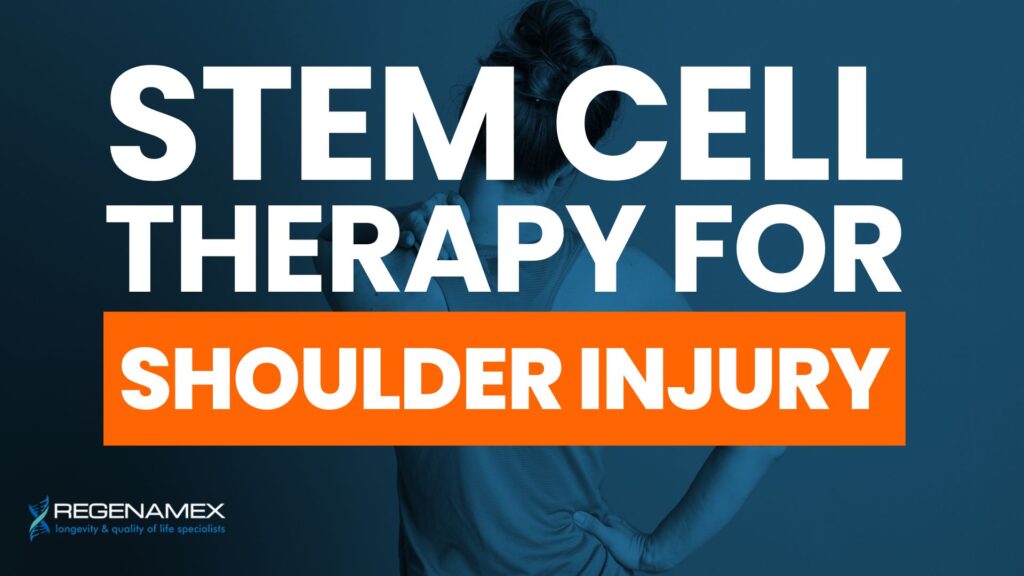
Stem Cell Therapy for Shoulder Injury: Regenerating the Joint Without Surgery
Stem cell therapy for shoulder injury is revolutionizing how doctors treat joint pain, torn tendons, and cartilage degeneration. Instead of resorting to invasive surgeries or temporary pain relief injections, this advanced regenerative approach uses mesenchymal stem cells (MSCs) to repair and restore damaged tissue at a cellular level. These powerful cells derived from placental tissue and Wharton’s jelly reduce inflammation, promote healing, and can even help regenerate soft tissue structures like tendons, ligaments, and cartilage that are essential for shoulder mobility and strength.
At Regenamex, a licensed regenerative medicine clinic in Mexico, stem cell therapy has become a cornerstone for patients suffering from chronic shoulder pain, rotator cuff tears, and sports-related injuries. Each treatment follows strict COFEPRIS (Mexican FDA equivalent) safety regulations and uses only ethically sourced, highly potent MSCs processed in GMP-certified laboratories. By combining stem cell therapy with complementary regenerative techniques such as PRP, exosomes, and IV nutrition, Regenamex offers patients an effective, minimally invasive alternative to surgery at a fraction of U.S. and Canadian prices.
Understanding Shoulder Injuries and Degeneration

The shoulder is a complex and highly mobile joint that allows for a wide range of movement, but this versatility also makes it one of the most vulnerable parts of the body. It depends on the harmony of bones, muscles, tendons, and ligaments that all work together to maintain stability and flexibility. Over time, this intricate balance can be disrupted by repetitive movements, poor posture, sports injuries, or the natural effects of aging. The result is often inflammation and micro-tears that develop into chronic conditions such as rotator cuff tears, bursitis, tendonitis, or shoulder osteoarthritis. When left untreated, these degenerative issues can lead to stiffness, weakness, and severe pain that interfere with even the simplest tasks—like reaching overhead or lifting light objects. For athletes and active individuals, these injuries can be career-altering, while for older adults, they can significantly diminish quality of life.
Traditional medical treatments like corticosteroid injections, physical therapy, or even surgical repair can temporarily reduce symptoms, but they rarely address the root cause of joint degeneration. Over time, the cartilage continues to wear away, inflammation persists, and pain often returns. Regenerative shoulder therapy changes that narrative by focusing on biological restoration rather than symptom suppression. By introducing mesenchymal stem cells (MSCs) directly into the damaged tissues, the therapy promotes cellular repair, restores tissue balance, and stimulates natural healing responses. This approach not only relieves pain but also encourages true regeneration of cartilage, tendon, and connective structures—allowing patients to recover both strength and mobility from the inside out.
How Stem Cell Therapy for Shoulder Injury Works
Stem cell therapy for shoulder injury is a non-surgical and highly precise procedure designed to trigger natural healing processes within the joint. Using image-guided ultrasound technology, a concentrated solution of mesenchymal stem cells (MSCs) is injected directly into the affected area—such as the rotator cuff tendons, joint capsule, or surrounding soft tissue. These cells act as biological messengers, releasing cytokines, exosomes, and growth factors that stimulate nearby dormant cells to repair damaged tissue. They also reduce inflammation by calming overactive immune cells and enhancing blood flow to promote oxygen and nutrient delivery where it’s most needed. This process helps relieve chronic pain, repair torn fibers, and restore optimal shoulder mobility—without the trauma or downtime of surgery.
At Regenamex, every treatment protocol is meticulously customized based on the patient’s diagnosis, degree of tissue injury, and overall health condition. All stem cell preparations are processed in GMP-certified laboratories, ensuring maximum sterility, safety, and cell potency. In cases involving complex or severe shoulder damage, Regenamex may combine MSC injections with platelet-rich plasma (PRP) or exosome therapy to enhance regenerative signaling and accelerate recovery. The entire procedure takes about one to two hours, involves local anesthesia only, and allows patients to resume normal activities within a few days. Because the treatment targets the biological foundation of joint degeneration, patients can expect gradual, lasting improvements over several months as the body’s own repair systems rebuild damaged tissue.
Conditions Treated with Regenerative Shoulder Therapy
Stem cell therapy can treat a wide range of shoulder conditions by targeting both acute injuries and chronic degeneration. Some of the most common issues treated with regenerative shoulder therapy include rotator cuff tears (partial or full-thickness), labral tears, bursitis, tendonitis, and shoulder arthritis. It’s also an excellent option for post-surgical rehabilitation, helping reduce scar tissue formation and accelerate recovery. For those suffering from frozen shoulder (adhesive capsulitis) or instability caused by repetitive overuse, stem cell injections can help restore flexibility and reduce stiffness by rejuvenating the inflamed connective tissues.
Because shoulder pain stem cell injections address the cellular cause of inflammation and tissue breakdown, they go far beyond surface-level relief. These regenerative therapies improve joint lubrication, repair microtears, and enhance blood circulation around the shoulder complex. For athletes and active individuals, the treatment can dramatically shorten recovery times after injury and help prevent re-injury by strengthening tendons and ligaments from within. Meanwhile, for older adults or patients with degenerative arthritis, stem cell therapy provides a safe, minimally invasive option to delay or even avoid shoulder replacement surgery while regaining comfort and independence in daily life.
Benefits of Stem Cell Therapy for Shoulder Injury
The benefits of stem cell therapy for shoulder injury extend far beyond pain relief. Patients often notice reduced inflammation, improved range of motion, and stronger joint stability within weeks of treatment. Because MSCs release powerful bioactive factors that stimulate tissue repair, the effects continue to build over time. In many cases, patients report steady improvement for up to six months after the procedure as the cells integrate into the body and sustain the healing process. This makes stem cell therapy particularly attractive for individuals looking to regain full function without invasive surgery or prolonged rehabilitation.
Unlike conventional treatments that provide only short-term results, regenerative therapies aim to create long-term change by addressing the root cause of joint degeneration. Improvements in cartilage density, tendon elasticity, and overall biomechanics contribute to lasting relief and reduced recurrence of pain. Moreover, the minimally invasive nature of the procedure means less downtime, fewer risks, and no general anesthesia. At Regenamex, patients also benefit from personalized aftercare that may include exosome boosters, IV nutrition, or hormone balancing to maximize results and enhance systemic healing.
What to Expect During a Regenamex Shoulder Treatment

Every Regenamex patient begins their journey with an in-depth medical evaluation, including advanced imaging studies such as MRI or ultrasound to assess the extent of shoulder damage. This initial consultation helps determine the right combination of stem cell concentration, injection sites, and complementary therapies for each individual. Once the treatment plan is established, the medical team explains every step of the process to ensure patients feel informed and confident before beginning.
On the day of the procedure, stem cells are injected under ultrasound guidance to ensure precise placement in the affected area. The process typically lasts one to two hours and is performed under local anesthesia, minimizing discomfort and eliminating the need for hospitalization. After a short recovery period, patients can return home and resume most daily activities within 24 to 48 hours. Over the next several weeks, stem cells begin to restore tissue structure and reduce inflammation. Regenamex schedules follow-up visits to track progress and may recommend maintenance sessions or adjunct treatments to sustain the healing process and optimize long-term outcomes.
Cost of Shoulder Stem Cell Therapy
The cost of stem cell therapy for shoulder injury can vary based on several important factors, including the source and quality of stem cells, the number of cells used, and whether complementary treatments like PRP or exosomes are added to the protocol. The severity of the injury, number of sessions required, and clinic location also play a role in determining overall pricing. At Regenamex, each quote is fully transparent and inclusive—covering laboratory processing, physician fees, imaging, and follow-up care.
In the United States and Canada, stem cell therapy for shoulder injuries can range between $8,000 to $15,000 USD per session, depending on complexity. By contrast, patients who travel to Mexico for treatment at Regenamex typically pay between $2,500 and $6,000 USD per session, with no compromise in safety or quality. The clinic’s Fly & Buy program makes international travel easy by coordinating flights, accommodations, and aftercare at reduced rates. This affordability, combined with world-class medical oversight, makes Mexico a leading destination for regenerative medicine patients seeking cost-effective, high-quality care.
Why Choose Regenamex for Regenerative Shoulder Therapy
Regenamex has established itself as a global leader in regenerative shoulder therapy by combining clinical precision with compassionate care. Every treatment uses COFEPRIS-approved Wharton’s jelly and placental MSCs, processed in GMP-certified laboratories for purity and potency. The clinic’s physicians are specialists in regenerative orthopedics, tailoring each therapy to the patient’s unique anatomy, injury severity, and personal goals. Beyond stem cell injections, Regenamex integrates supportive treatments like PRP, exosomes, hormone optimization, and IV nutrient therapy to maximize healing potential.
Located in Puerto Vallarta and Tijuana, Regenamex welcomes international patients seeking top-tier regenerative care at a fraction of the cost found in the U.S. or Canada. Every patient receives detailed aftercare instructions, follow-up evaluations, and continuous communication with the medical team. Many report not just improved shoulder strength and flexibility, but also enhanced energy, reduced inflammation, and better overall vitality. Regenamex’s commitment to transparency, ethical sourcing, and scientific integrity makes it one of the most trusted clinics for those pursuing cutting-edge regenerative solutions worldwide.
FAQs: Stem Cell Therapy for Shoulder Injury
Stem cell therapy for shoulder injury is a cutting-edge regenerative treatment designed to heal the joint at the cellular level rather than simply mask pain. It involves the use of mesenchymal stem cells (MSCs)—powerful repair cells capable of transforming into cartilage, bone, or tendon tissue. When injected into damaged areas of the shoulder, these cells help reduce inflammation, promote collagen production, and stimulate the body’s natural repair mechanisms. Over time, this process strengthens weakened tissues, improves flexibility, and restores normal shoulder function. At Regenamex, the therapy is performed using ethically sourced MSCs from Wharton’s jelly and placental tissue, ensuring maximum potency and safety under COFEPRIS regulatory oversight.
Shoulder pain stem cell injections work by delivering highly concentrated MSCs directly to the damaged or inflamed regions of the shoulder, such as the rotator cuff tendons or the joint capsule. Once introduced, these cells begin releasing growth factors, cytokines, and exosomes—tiny communication molecules that signal the body’s natural healing systems to activate. They also calm chronic inflammation, stimulate blood vessel growth, and enhance nutrient delivery to damaged tissue. Unlike cortisone or steroid injections that provide only short-term relief, stem cell injections work biologically to repair and rebuild tissue over time. The result is a stronger, more resilient shoulder joint that continues to improve months after the procedure.
Stem cell therapy can address a broad range of shoulder injuries and degenerative conditions that cause chronic pain or limited movement. This includes rotator cuff tears, labral injuries, tendonitis, bursitis, frozen shoulder, and osteoarthritis of the shoulder joint. It is also highly beneficial for post-surgical patients who struggle with scar tissue or delayed healing. Because regenerative shoulder therapy enhances cellular regeneration, it can also be used preventatively for athletes or individuals prone to overuse injuries. By improving tissue strength and reducing inflammation, this therapy helps restore natural shoulder mechanics and improves overall function—without the downtime or risks associated with surgery.
The effectiveness of rotator cuff stem cell therapy depends on factors such as the extent of the tear, overall joint condition, and patient health—but clinical studies have shown remarkable success in many cases. Research published in The American Journal of Sports Medicine and BioMed Research International has demonstrated that MSC injections can significantly reduce shoulder pain, improve tendon integrity, and restore full range of motion. Patients often experience measurable gains within a few months, as inflammation subsides and tissue regeneration begins. For partial tears and early-stage degeneration, stem cell therapy has even helped some patients avoid surgery altogether, allowing for faster recovery and lasting joint stability.
The healing process following stem cell therapy for shoulder injury unfolds gradually, as the cells need time to repair tissue and regulate inflammation. Many patients begin noticing subtle improvements—such as reduced pain, less stiffness, and greater mobility—within the first few weeks. More pronounced benefits, including enhanced strength and sustained pain relief, typically emerge between three and six months post-treatment as new tissue growth occurs. The regenerative process continues for months after the initial injection, meaning results often become progressively better over time. Patients who follow recommended rehabilitation programs and maintain a healthy lifestyle generally experience faster and more complete recoveries.
When performed in regulated medical environments like Regenamex, regenerative shoulder therapy is considered very safe. All procedures are carried out by experienced physicians under COFEPRIS (Mexico’s FDA equivalent) supervision, ensuring adherence to the highest safety and sterility standards. The MSCs used are ethically sourced from Wharton’s jelly and placental tissue—completely biocompatible and free from rejection risk. Since the treatment is minimally invasive and requires no general anesthesia, complications such as infection or nerve damage are exceedingly rare. Patients may experience mild swelling or soreness at the injection site for a day or two, but these effects resolve quickly as the regenerative process begins to take hold.

